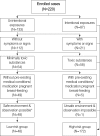Triage method for out-of-hospital poisoned patients
- PMID: 17449946
- PMCID: PMC2693604
- DOI: 10.3346/jkms.2007.22.2.336
Triage method for out-of-hospital poisoned patients
Abstract
The aim of this study was to develop and evaluate a triage method to prevent unnecessary emergency department visits of out-of-hospital poisoned patients. From October 2003 to September 2004, the calls that lay persons gave to the Seoul Emergency Medical Information Center to seek advice on the out-of-hospital poisoned patients were enrolled. We designed a triage protocol that consisted of five factors and applied it to the patients. According to the medical outcomes, we classified the patients into two groups, the toxicity-positive and the toxicity-negative. We arranged the factors on the basis of the priority that was determined in order of the odds ratio of each factor for the toxicity-positive and made a flow chart as a triage method. Then we calculated a sensitivity, specificity, positive predictive value and negative predictive value of the method. We regarded the specificity as the ability of the method and the sensitivity as the safety. A total of 220 patients were enrolled in this study. The method showed a sensitivity, specificity, positive predictive value, and negative predictive value of 99.2%, 53.4%, 76.2%, and 97.9%, respectively. Our triage method prevented 53.4% of the unnecessary emergency department visits of out-of-hospital acutely poisoned patients, safely.
Figures


Similar articles
-
A comparison of emergency triage scales in triaging poisoned patients.Australas Emerg Nurs J. 2014 Nov;17(4):184-9. doi: 10.1016/j.aenj.2014.05.004. Epub 2014 Jul 4. Australas Emerg Nurs J. 2014. PMID: 25443430
-
Methylphenidate intoxications in children and adults: exposure circumstances and evidence-based dose threshold for pre-hospital triage.Clin Toxicol (Phila). 2015 Mar;53(3):168-77. doi: 10.3109/15563650.2015.1004579. Epub 2015 Feb 4. Clin Toxicol (Phila). 2015. PMID: 25650984
-
Intentional drug poisoning care in a physician-manned emergency medical service.Prehosp Emerg Care. 2015 Apr-Jun;19(2):224-31. doi: 10.3109/10903127.2014.964890. Epub 2014 Oct 28. Prehosp Emerg Care. 2015. PMID: 25350772
-
Methylphenidate poisoning: an evidence-based consensus guideline for out-of-hospital management.Clin Toxicol (Phila). 2007 Oct-Nov;45(7):737-52. doi: 10.1080/15563650701665175. Clin Toxicol (Phila). 2007. PMID: 18058301
-
Tricyclic antidepressant poisoning: an evidence-based consensus guideline for out-of-hospital management.Clin Toxicol (Phila). 2007;45(3):203-33. doi: 10.1080/15563650701226192. Clin Toxicol (Phila). 2007. PMID: 17453872
References
-
- Litovitz TL, Klein-Schwartz W, White S, Cobaugh DJ, Youniss J, Omslaer JC, Drab A, Benson BE. 2000 annual report of the American Association of Poison Control Centers Toxic Exposure Surveillance System. Am J Emerg Med. 2001;19:337–395. - PubMed
-
- McGuigan MA. Guideline Consensus Panel: Guideline for the out-of-hospital management of human exposures to minimally toxic substances. J Toxicol Clin Toxicol. 2003;41:907–917. - PubMed
-
- Chafee-Bahamon C, Lovejoy FH. Effectiveness of a regional poison center in reducing excess emergency room visits for children's poisonings. Pediatrics. 1983;72:164–169. - PubMed
-
- Litovitz TL. The TESS database. Use in product safety assessment. Drug Saf. 1998;18:9–19. - PubMed
Publication types
MeSH terms
LinkOut - more resources
Full Text Sources
Medical

